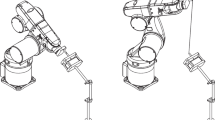Abstract
In the context of Industry 4.0, the human-robot interaction (HRI) can be improved by tracking the human arm in the workspace shared with the robot. This goal takes advantage of a customized human arm modeling and it should be conveniently achieved with a limited number of sensors and a reduced computational time. In this paper, considering the analogy between human and robotic arms, a new method for the identification of a custom-made human arm model was inspired by a robot calibration process. The Denavit-Hartenberg (DH) parameters of the arm model were estimated recording a suitable number of hand poses. Hence, a robotic arm was exploited to test the new method. To simplify the fitting procedure of a reliable robot model, the minimum number of the necessary end-effector (EE) poses was investigated. Through an optoelectronic system, the EE pose trajectory of a UR3 robot was recorded. The optimization of the DH parameters was repeatedly run decreasing the downsampling frequency of the acquired data and then the trajectory error was evaluated. A new reference dataset of robot configurations was acquired permutating the joints degrees of freedom among values of 0, +90, or −90°. Hence, the method to fit the model considering few EE poses was tested on six robot configurations randomly selected from the dataset. Overall, trajectory errors highlighted the applicability of this method in the context of HRI.
Access this chapter
Tax calculation will be finalised at checkout
Purchases are for personal use only
Similar content being viewed by others
References
Ajoudani, A., Zanchettin, A.M., Ivaldi, S., Albu-Schäffer, A., Kosuge, K., Khatib, O.: Progress and prospects of the human–robot collaboration. Auton. Robots 42, 957–975 (2018). https://doi.org/10.1007/s10514-017-9677-2
Bauer, A., Wollherr, D., Buss, M.: Human–robot collaboration: a survey. Int. J. Humanoid Robot. 5, 47–66 (2008)
Lasota, P.A., Fong, T., Shah, J.A.: A survey of methods for safe human-robot interaction. Found. Trends Robot. 5, 261–349 (2017). https://doi.org/10.1561/2300000052
Melchiorre, M., Scimmi, L.S., Mauro, S., Pastorelli, S.P.: Vision-based control architecture for human–robot hand-over applications. Asian J. Control, 105–117 (2020). https://doi.org/10.1002/asjc.2480
Scimmi, L.S., Melchiorre, M., Mauro, S., Pastorelli, S.P.: Implementing a vision-based collision avoidance algorithm on a UR3 robot. In: 2019 23rd International Conference Mechatronics Technology ICMT 2019 (2019). https://doi.org/10.1109/icmect.2019.8932105
Digo, E., Antonelli, M., Pastorelli, S., Gastaldi, L.: Upper limbs motion tracking for collaborative robotic applications. In: International Conference on Human Interaction and Emerging Technologies (2020)
Digo, E., Antonelli, M., Cornagliotto, V., Pastorelli, S., Gastaldi, L.: Collection and analysis of human upper limbs motion features for collaborative robotic applications. Robotics (2020). https://doi.org/10.3390/robotics9020033
Laitenberger, M., Raison, M., Périé, D., Begon, M.: Refinement of the upper limb joint kinematics and dynamics using a subject-specific closed-loop forearm model. Multibody Syst. Dyn. 33, 413–438 (2015). https://doi.org/10.1007/s11044-014-9421-z
Reinbolt, J.A., Schutte, J.F., Fregly, B.J., Koh, B. Il, Haftka, R.T., George, A.D., Mitchell, K.H.: Determination of patient-specific multi-joint kinematic models through two-level optimization. J. Biomech. 38, 621–626 (2005). https://doi.org/10.1016/j.jbiomech.2004.03.031
Ayusawa, K., Ikegami, Y., Nakamura, Y.: Simultaneous global inverse kinematics and geometric parameter identification of human skeletal model from motion capture data. Mech. Mach. Theory 74, 274–284 (2014). https://doi.org/10.1016/j.mechmachtheory.2013.12.015
Begon, M., Wieber, P.B., Yeadon, M.R.: Kinematics estimation of straddled movements on high bar from a limited number of skin markers using a chain model. J. Biomech. 41, 581–586 (2008). https://doi.org/10.1016/j.jbiomech.2007.10.005
Prokopenko, R.A., Frolov, A.A., Biryukova, E.V., Roby-Brami, A.: Assessment of the accuracy of a human arm model with seven degrees of freedom. J. Biomech. 34, 177–185 (2001). https://doi.org/10.1016/S0021-9290(00)00179-2
Nubiola, A., Bonev, I.A.: Absolute calibration of an ABB IRB 1600 robot using a laser tracker. Robot. Comput. Integr. Manuf. 29, 236–245 (2013). https://doi.org/10.1016/j.rcim.2012.06.004
Zhang, X., Song, Y., Yang, Y., Pan, H.: Stereo vision based autonomous robot calibration. Rob. Auton. Syst. 93, 43–51 (2017). https://doi.org/10.1016/j.robot.2017.04.001
Meng, Y., Zhuang, H.: Autonomous robot calibration using vision technology. Robot. Comput. Integr. Manuf. 23, 436–446 (2007). https://doi.org/10.1016/j.rcim.2006.05.002
Motta, J.M.S.T., De Carvalho, G.C., McMaster, R.S.: Robot calibration using a 3D vision-based measurement system with a single camera. Robot. Comput. Integr. Manuf. 17, 487–497 (2001). https://doi.org/10.1016/S0736-5845(01)00024-2
Zhang, T., Song, Y., Wu, H., Wang, Q.: A novel method to identify DH parameters of the rigid serial-link robot based on a geometry model. Ind. Rob. (2020). https://doi.org/10.1108/IR-05-2020-0103
Gao, G., Sun, G., Na, J., Guo, Y., Wu, X.: Structural parameter identification for 6 DOF industrial robots. Mech. Syst. Signal Process. 113, 145–155 (2018). https://doi.org/10.1016/j.ymssp.2017.08.011
Gates, D.H., Walters, L.S., Cowley, J., Wilken, J.M., Resnik, L.: Range of motion requirements for upper-limb activities of daily living. Am. J. Occup. Ther. 70 (2016)
Author information
Authors and Affiliations
Corresponding author
Editor information
Editors and Affiliations
Rights and permissions
Copyright information
© 2021 The Author(s), under exclusive license to Springer Nature Switzerland AG
About this paper
Cite this paper
Cornagliotto, V., Digo, E., Pastorelli, S. (2021). Using a Robot Calibration Approach Toward Fitting a Human Arm Model. In: Zeghloul, S., Laribi, M.A., Sandoval, J. (eds) Advances in Service and Industrial Robotics. RAAD 2021. Mechanisms and Machine Science, vol 102. Springer, Cham. https://doi.org/10.1007/978-3-030-75259-0_22
Download citation
DOI: https://doi.org/10.1007/978-3-030-75259-0_22
Published:
Publisher Name: Springer, Cham
Print ISBN: 978-3-030-75258-3
Online ISBN: 978-3-030-75259-0
eBook Packages: Intelligent Technologies and RoboticsIntelligent Technologies and Robotics (R0)




